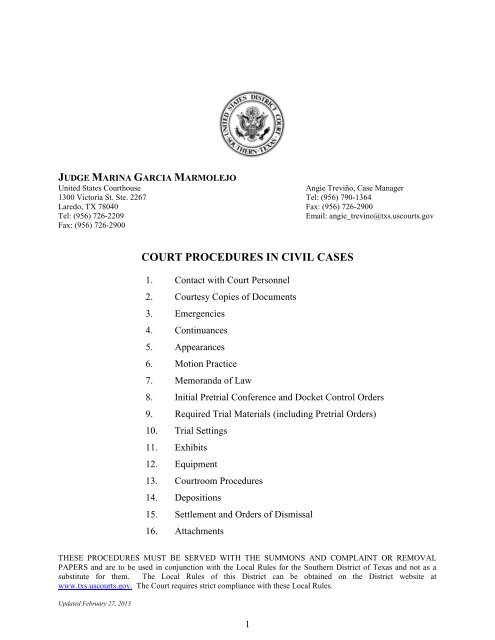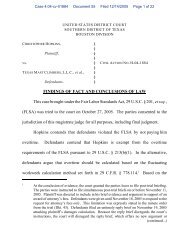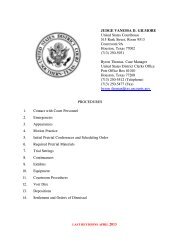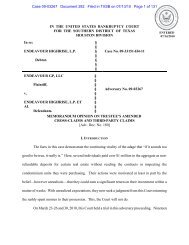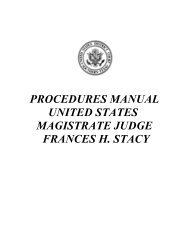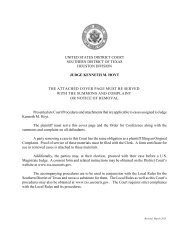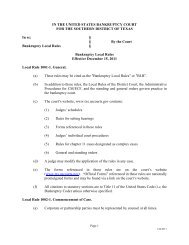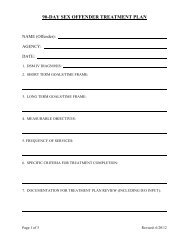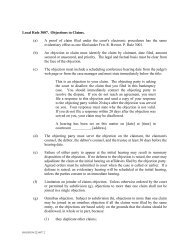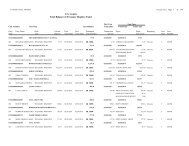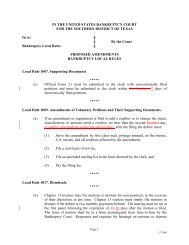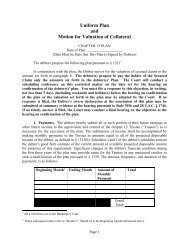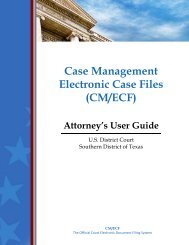COURT PROCEDURES IN CIVIL CASES - Southern District of Texas
COURT PROCEDURES IN CIVIL CASES - Southern District of Texas
COURT PROCEDURES IN CIVIL CASES - Southern District of Texas
- No tags were found...
Create successful ePaper yourself
Turn your PDF publications into a flip-book with our unique Google optimized e-Paper software.
JUDGE MAR<strong>IN</strong>A GARCIA MARMOLEJOUnited States CourthouseAngie Treviño, Case Manager1300 Victoria St. Ste. 2267 Tel: (956) 790-1364Laredo, TX 78040 Fax: (956) 726-2900Tel: (956) 726-2209Email: angie_trevino@txs.uscourts.govFax: (956) 726-2900<strong>COURT</strong> <strong>PROCEDURES</strong> <strong>IN</strong> <strong>CIVIL</strong> <strong>CASES</strong>1. Contact with Court Personnel2. Courtesy Copies <strong>of</strong> Documents3. Emergencies4. Continuances5. Appearances6. Motion Practice7. Memoranda <strong>of</strong> Law8. Initial Pretrial Conference and Docket Control Orders9. Required Trial Materials (including Pretrial Orders)10. Trial Settings11. Exhibits12. Equipment13. Courtroom Procedures14. Depositions15. Settlement and Orders <strong>of</strong> Dismissal16. AttachmentsTHESE <strong>PROCEDURES</strong> MUST BE SERVED WITH THE SUMMONS AND COMPLA<strong>IN</strong>T OR REMOVALPAPERS and are to be used in conjunction with the Local Rules for the <strong>Southern</strong> <strong>District</strong> <strong>of</strong> <strong>Texas</strong> and not as asubstitute for them. The Local Rules <strong>of</strong> this <strong>District</strong> can be obtained on the <strong>District</strong> website atwww.txs.uscourts.gov. The Court requires strict compliance with these Local Rules.Updated February 27, 20131
1. CONTACT WITH <strong>COURT</strong> PERSONNELA. The Court requires that parties will file documents through the <strong>District</strong>Court’s Case Management/Electronic Case Filing (“CM/ECF”) System. See<strong>Southern</strong> <strong>District</strong> <strong>of</strong> <strong>Texas</strong> Local Rule 5.1 (LR 5.1) and the <strong>District</strong>’sAdministrative Procedures for CM/ECF (as amended and available at the<strong>District</strong>’s website, www.txs.uscourts.gov).B. Case-related telephone and email inquiries are strictly limited toprocedural matters and should be made only to the Case Manager.Inquiries should not be made to the Court’s secretary or law clerks. TheCourt’s caseload does not allow the Case Manager to respond to casualtelephone inquiries about the status <strong>of</strong> motions or cases. All inquiries to theCase Manager should be by letter sent or delivered to Chambers, or by email.See below.C. Information about the status <strong>of</strong> documents, entry <strong>of</strong> orders, or docket entriesshould be obtained from the CM/ECF or Pacer Systems, or if absolutelynecessary, from the United States <strong>District</strong> Clerk’s Office at (956) 723-3542.D. Correspondence with the Court must be delivered or sent to the Court’sChambers:1) Case-related correspondence should be addressed to:Angie TreviñoCase Manager to <strong>District</strong> Judge Marina Garcia Marmolejo1300 Victoria St., Ste. 2267Laredo, TX 78040Or by email: angie_trevino@txs.uscourts.gov2) Do not address substantive issues in letter or email form. The partiesmust file copies <strong>of</strong> all letters. Email correspondence with the Courtwill be docketed at the Court’s discretion.3) Copies <strong>of</strong> urgent documents (including letters) may be sent by FirstClass Mail, emailed, or hand-delivered to Chambers (seeEmergencies, § 3 below), to the Court’s Case Manager, with copies toall parties. Service copies must be transmitted to all counsel <strong>of</strong> recordsimultaneously with (or prior to) and in the same manner as thedocument is transmitted to the Court. The documents may not befaxed without express prior permission <strong>of</strong> the Court.2
2. <strong>COURT</strong>ESY COPIES OF DOCUMENTSA. Letters to the Court may be hand-delivered, sent by First Class Mail toChambers, or transmitted by email, with copies to all parties served prior toor at the time <strong>of</strong> filing. See addresses above. Letters concerning discoveryand scheduling matters must be filed in the docket.B. The parties must forward promptly to Chambers courtesy copies <strong>of</strong> (i) alldocuments that exceed ten (10) pages in length, including exhibits andattachments, and (ii) documents pertaining to matters to be heard by the courtwithin seven (7) days after the document is filed. Unless this rule isfollowed, the court will not consider any documents filed within seven (7)days <strong>of</strong> any court appearance. Do not fax or email copies <strong>of</strong> documents toChambers unless specifically authorized to do so by the court.3. EMERGENCIESA. Applications for restraining orders or for other immediate relief shall be filedelectronically through the CM/ECF system and all related communicationswith the Court must be through the Case Manager.1) Such applications shall be presented to the Court by the CaseManager following counsel’s affirmation that the opposing party hasbeen contacted and that both parties can be available for a conferencebefore the Court, or an explanation <strong>of</strong> why such contact is not legallyrequired.2) Ex parte applications for restraining orders will not be entertained bythe Court unless the requirements <strong>of</strong> FED. R. CIV. P. 65(b) have beensatisfied.B. Motions for extension <strong>of</strong> deadlines or cut-<strong>of</strong>f dates in the Docket ControlOrder are not emergencies. (See Continuances, § 4 below.)4. CONT<strong>IN</strong>UANCESA. Motions for continuance must be filed at least three (3) business daysprior to date <strong>of</strong> the controlling deadline and will be granted only at theCourt’s discretion. Motions for continuance filed on the date <strong>of</strong> thedeadline, absent a showing <strong>of</strong> good cause, will not be granted.B. Agreements or joint motions among counsel for continuance are not bindingon the Court. Parties must notify the Court <strong>of</strong> agreed continuances bysubmitting an agreed motion and proposed order.3
C. A trial will not be continued because <strong>of</strong> the unavailability <strong>of</strong> a witness.Counsel are expected to anticipate such possibilities and should be preparedto present testimony by written deposition, videotaped deposition, or bystipulation.5. APPEARANCESA. An attorney who appears at a hearing or conference must:1) be familiar with the case,2) have authority to bind the client, and3) be in charge for that appearance.B. All counsel wishing to appear at a conference or hearing by telephone mustsubmit a written request by e-mail to the Case Manager as far in advance <strong>of</strong>the conference as reasonably possible. The Court will attempt toaccommodate such requests.C. Failure to appear when notified <strong>of</strong> a setting may subject the attorney and/orhis or her client to sanctions, including dismissal for want <strong>of</strong> prosecutionand/or other appropriate order or judgment.D. Motions for admission pro hac vice shall include the attorney applicant’saverment that he or she has familiarized him/herself with the Local Rules <strong>of</strong>the <strong>Southern</strong> <strong>District</strong> <strong>of</strong> <strong>Texas</strong> and these Procedures applicable to civil casesbefore Judge Garcia Marmolejo. (See attached form, also available at theCourt’s website.)6. MOTION PRACTICEA. General Guidelines. The Court follows the written motion practicedescribed in the Local Rules. In addition, the following procedures apply:1) Counsel must make serious and timely efforts to confer opposingcounsel on all motions to try to reach agreements on the relief to berequested by movant.2) Every non-dispositive motion must contain a certificate <strong>of</strong>conference. Failure to comply may result in the party’s pleadingbeing denied or stricken.3) All motions except summary judgment motions filed pursuant to FED.R. CIV. P. 56 must be accompanied by a separate proposed ordergranting or denying the relief requested.4
4) Opposed motions generally will be considered by the Court afterexpiration <strong>of</strong> 28 days from the motion filing date. Responses by thenon-movant must be filed within 21 calendar days <strong>of</strong> the motion.Movant’s reply must be filed within 7 calendar days after the nonmovant’sresponse.When circumstances dictate, the Court may consider a motion prior toexpiration <strong>of</strong> the 28 day period.The parties by agreement may extend a motion submission day, butmust give the Court prompt written notice <strong>of</strong> the agreement, with aproposed order granting the extension. Parties’ agreed extensions inviolation <strong>of</strong> a Court-imposed deadline require Court approval.5) Because most motions will be ruled on without an oral hearing,focused, clear motion papers are very important. Requests for oralargument on motions are not necessary. The Case Manager willnotify counsel should the Court determine that oral argument wouldbe beneficial.6) All pleadings or other documents filed under seal in a civil case mustbe identified as “SEALED” in the title <strong>of</strong> the document. Forexample, a motion for summary judgment filed under seal must bedocketed as “MOTION for Summary Judgment (SEALED).” Nopleading may be filed for docketing simply as “SEALEDDOCUMENT” without advance permission <strong>of</strong> the Court.7) Any pleadings filed with the court, including exhibits thereto,containing personal data identifiers must comply with the S.D. <strong>Texas</strong>General Order #2004-11 (available at the <strong>District</strong>’s website) onprotecting personal privacy in public case files.B. Submitted Motions – Need for Expedited Decision.1. The Court will rule on motions as soon as possible after thesubmission day or a response is filed. See § 6.A.4 above. Counsel <strong>of</strong>record and pro se parties will be furnished with copies <strong>of</strong> orders.2. If a pending motion requires resolution on an expedited basis, pleaseadvise the Court by letter.E. Discovery and Scheduling Disputes.1. The court believes that most discovery and schedule-related disputes,especially those dealing with (i) scheduling, (ii) the number, length5
and form <strong>of</strong> oral and written questions, (iii) the responsiveness <strong>of</strong>answers to oral and written questions, and (iv) the mechanics <strong>of</strong>document productions, including protective orders and the propermethod <strong>of</strong> raising claims <strong>of</strong> privilege, can be resolved by counselwithout the intervention <strong>of</strong> the court. Counsel are responsible forconferring in good faith to resolve discovery and schedulingdisputes.2. If counsel for the parties are unable to reach an agreement, the motionMUST contain a certificate <strong>of</strong> conference pursuant to LR 7.1D andspecify the date, time and place <strong>of</strong> the parties’ prior out-<strong>of</strong>-courtdiscovery or scheduling discussion(s), the names <strong>of</strong> all counselparticipating therein, and give a brief summary <strong>of</strong> the results <strong>of</strong> thediscussions.7. MEMORANDA OF LAWA. Page Limits and Briefing Requirements. The Court requires concise,pertinent and well organized memoranda <strong>of</strong> law. Without leave <strong>of</strong> Court, allmemoranda <strong>of</strong> law are limited to 25 pages, 12-point type-font, doublespaced,with 1" margins. All memoranda <strong>of</strong> law must contain items 3, 4, 6,and 7 below. Any memorandum that has more than ten (10) pages <strong>of</strong>argument must contain the following eight (8) items.1) A table <strong>of</strong> contents setting forth the page number <strong>of</strong> each section,including all headings designated in the body <strong>of</strong> the brief ormemorandum.2) A table <strong>of</strong> citations <strong>of</strong> cases, statutes, rules, textbooks and otherauthorities, alphabetically arranged.3) A short statement <strong>of</strong> the nature and stage <strong>of</strong> the proceeding.4) A statement <strong>of</strong> the issues to be ruled upon by the Court and, withrespect to each issue a short statement (supported by authority) <strong>of</strong> thestandard <strong>of</strong> review.5) A short summary <strong>of</strong> the argument.6) Succinct headings dividing the argument into separate points.7) A short conclusion stating the precise relief sought.8) Proposed orders (except on summary judgment motions).6
B. Copies <strong>of</strong> Authorities and Other Material Cited.1) Please append copies <strong>of</strong> cases and the relevant parts <strong>of</strong> authorities thatare cited in a brief, memorandum, or motion only if the authorities arenot published or reasonably available through Westlaw or Lexis-Nexis.2) Copies <strong>of</strong> supporting affidavits, deposition testimony excerpts, andother discovery referred to in the briefs should be separately filed inone or more appendices <strong>of</strong> no more than 40 pages each.3) All appendices should contain a table <strong>of</strong> contents, and courtesy copies<strong>of</strong> appendices or those filed conventionally (i.e., not electronically)should be tabbed at the right margin to facilitate location <strong>of</strong> thematerials cited.8. <strong>IN</strong>ITIAL PRETRIAL CONFERENCES AND DOCKET CONTROL ORDERSPlease refer to LR 16.1 and Section 5 above (“Appearances”) for general proceduresfor conferences. In addition:A. After a party files or removes a case, the Court will issue an order providinga deadline by which the joint discovery/case management plan must be filed.B. At the Initial Pretrial Conference in civil cases, the Court will enter a DocketControl Order.1) The parties may agree on deadlines for completion <strong>of</strong> pretrial mattersand file a proposed Docket Control Order to the Initial PretrialConference.2) The Docket Control Order will govern throughout the case. TheDocket Control Order deadlines shall not be modified except by leave<strong>of</strong> this Court upon a showing <strong>of</strong> good cause.3) If a change to an existing Docket Control Order is requested, theparties shall submit recommendations for adjusting all dates in theDocket Control Order that follow the date sought to be modified.4) Counsel shall include in their filings their email addresses.C. Added Parties. If new parties are joined after entry <strong>of</strong> the Docket ControlOrder, the party causing such joinder shall provide to the new parties copies<strong>of</strong>: (i) all orders and pleadings previously filed in the case, (ii) the operativeDocket Control Order, and (iii) these Court Procedures.7
9. REQUIRED TRIAL MATERIALSA. Joint Pretrial Order. Joint Pretrial Orders must be signed by all counsel.All parties are responsible for complying with all requirements to preparethe Joint Pretrial Order.1) Plaintiff is primarily responsible for ensuring that a complete JointPretrial Order is filed timely. A form Joint Pretrial Order is attachedand is available in the Court’s website. It should be followed, butmay be adapted, within reason, to accommodate the size and nature <strong>of</strong>the case. If plaintiff fails to file the Joint Pretrial Order, then thedefendant is responsible for filing defendant’s portions <strong>of</strong> a ProposedPretrial Order in the Joint Pretrial Order format.2) Plaintiff must deliver to Court’s Chambers a courtesy copy <strong>of</strong> theJoint Pretrial Order with all attachments.3) Failure to file the Joint Pretrial Order timely will subject counsel andthe client to sanctions, including dismissal for want <strong>of</strong> prosecutionand/or other appropriate relief. This applies also to parties appearingpro se.B. Other Required Documents. With the filing <strong>of</strong> the Joint Pretrial Order,each party also must file:1) For All Trials and Evidentiary Hearings:a. Exhibit List (see attached form, also available at the Court’swebsite).b. Witness List for live witnesses (see attached form, alsoavailable at the Court’s website).c. Designation <strong>of</strong> deposition excerpts for witnesses being calledby deposition. A copy <strong>of</strong> each deposition excerpt must beprovided to the Court.d. Objections, if any, to an opponent’s exhibits, witnesses ordepositions excerpts must be filed within fourteen (14)calendar days prior to the scheduled trial date. This timelimit supersedes LR 46.2) For Jury Trials:a. Voir Dire: Counsel will be generally allowed 15-35 minutes(depending on the complexity <strong>of</strong> the case) to conduct an8
examination <strong>of</strong> the venire, provided that the proposed voirdire questions are submitted as part <strong>of</strong> the Joint Pretrial Order.b. Jury Instructions: The parties must file a single, jointproposed jury charge, including all necessary instructions,definitions and questions. The proposed charges must also besubmitted electronically in a CD in Corel WordPerfect orMicros<strong>of</strong>t Word.i) Each requested instruction must be numbered andpresented with authority.ii)iii)The parties shall include in the proposed jury chargeall necessary instructions or definitions. Theinstructions shall, at a minimum, include: (1) the primafacie elements <strong>of</strong> each cause <strong>of</strong> action and defenseasserted, (2) legal definitions required by the jury, (3)items <strong>of</strong> damages, and (4) methods <strong>of</strong> calculation <strong>of</strong>damages. Counsel are to use the Fifth Circuit PatternJury Instructions, as modified by case law or statutoryamendments, whenever possible. Any deviations mustbe identified, and accompanied with legal authoritiesfor the proposed deviation.Even if the parties, in good faith, cannot agree on allinstructions, definitions or questions, the parties shouldnonetheless submit a single, unified charge. Eachdisputed instruction, definition, or question should beset out in bold type, underlined or italics and identifiedas disputed. Each disputed item should be labeled toshow which party is requesting the disputed language.Accompanying each instruction shall be all authorityor related materials upon which each party relies.c. The parties shall submit a trial memorandum <strong>of</strong> lawaddressing the law governing the case and all contested issues.3) For Non-Jury Trials, each party must file:a. Proposed Findings <strong>of</strong> Fact (electronically in CorelWordPerfect X3 or higher, or Micros<strong>of</strong>t Word). Counsel arestrongly encouraged to include references to testimony andexhibits which support each proposed finding;b. Proposed Conclusions <strong>of</strong> Law (electronically in CorelWordPerfect X3 or higher, or Micros<strong>of</strong>t Word). Each9
10. TRIAL SETT<strong>IN</strong>GSproposed conclusion <strong>of</strong> law will contain citation <strong>of</strong> legalauthority supporting the conclusions; andc. Memorandum <strong>of</strong> Law. The memorandum <strong>of</strong> law, proposedfindings, and proposed conclusions should, at a minimum,address the following: (1) the prima facie elements <strong>of</strong> eachcause <strong>of</strong> action and defense asserted, (2) legal definitions, (3)components <strong>of</strong> damages, and (4) methods <strong>of</strong> calculation <strong>of</strong>damages.A. The Court sets trial dates at Docket Call in civil cases. Docket Call is a finalpretrial conference. Parties should be prepared to answer questions on allpending motions. Pending motions may be ruled on at Docket Call. Trialmay be set for any day after the Docket Call.B. Unless an attorney has actually commenced trial in court, another trial settingwill not cause the Court to pass a trial setting in a case.C. Information on Trial Settings: The Case Manager cannot definitivelyascertain when a case will be reached or where a case is on the trial docket.Any predictions given by the Case Manager are only “educated guesses” andare NOT binding on the Court.11. EXHIBITSA. All exhibits must be pre-marked and exchanged among counsel at the timethe Pretrial Order is filed, unless a later date is agreed to by counsel.Generally, in civil cases, exhibits that have not been disclosed to opposingcounsel prior to trial will not be received in evidence. The <strong>of</strong>fering partyshall mark its name, the case number, and the exhibit number on each exhibitto be <strong>of</strong>fered. Any exhibits containing personal data identifiers must complywith S.D. <strong>Texas</strong> General Order #2004-11 (available at the <strong>District</strong> website).B. Authentication Objections. Counsel requiring authentication <strong>of</strong> anopponent’s exhibit must notify <strong>of</strong>fering counsel in writing within seven (7)days after the exhibit is identified and made available for examination.Failure to do so is an admission <strong>of</strong> authenticity. See LR 44.1.C. Other Objections to Exhibits. Unless otherwise directed by the Court, aparty in a civil case may <strong>of</strong>fer in evidence any exhibits listed in the final JointPretrial Order unless opposing counsel files specific written objectionswithin fourteen (14) calendar days prior to the scheduled trial date. Thistime limit supersedes LR 46. The Court endeavors to rule on objections to10
exhibits outside the presence <strong>of</strong> the jury and will do so prior to openingstatements, to the extent possible.D. Copies <strong>of</strong> Exhibits. The parties must provide the Court with two (2)complete sets <strong>of</strong> exhibits for use at trial in a properly tabbed and indexednotebook.E. Trial Procedure as to Exhibits.1) Counsel may not pass exhibits to the jury during trial withoutobtaining permission in advance from the Court.2) Exhibits must be identified in front <strong>of</strong> the jury before they will bereceived in evidence. Only exhibits admitted during trial will go tothe jury during its deliberations.F. Disposition <strong>of</strong> Exhibits. Counsel should become familiar with LR 79.2regarding disposition <strong>of</strong> exhibits following trial.12. EQUIPMENTA. Sound and Video Equipment. The Court has projection, document camera,sound and video equipment in the courtroom. Counsel are invited to use thatequipment during trial. Counsel who seek to test the equipment prior to trialshall contact the Case Manager by e-mail, letter or phone to makearrangements to test the equipment. Parties also may provide their ownequipment, but special arrangements must be made with the Case Managerprior to the day <strong>of</strong> trial.B. Other. Easels with writing pads are available for use in the Courtroom, uponrequest to the Case Manager prior to trial.13. <strong>COURT</strong>ROOM <strong>PROCEDURES</strong>A. Hours. The Court’s hours during trial will vary depending upon the type <strong>of</strong>case and the needs <strong>of</strong> the parties, counsel, witnesses, and the Court. Courtnormally will convene at 8:30 a.m. and adjourn by 5:30 p.m., with a 12:00 to1:30 p.m. lunch recess.B. Access at Other Times.1) Counsel needing access to the Courtroom to set up equipment orexhibits must arrange access in advance with the Case Manager orchambers to have the Courtroom open.11
2) Enter and leave the Courtroom only by the front doors; do not use theCourt’s entrance or the side entrances without permission.C. Telephones. Telephone messages for counsel generally will not be taken bythe Judge’s staff, and counsel shall refrain from requesting use <strong>of</strong> telephonesin Chambers.D. Filing <strong>of</strong> Documents. Handing documents to the Court or Case Managerdoes not constitute filing <strong>of</strong> the documents in the CM/ECF system.1) All original documents must be filed through the CM/ECF system.2) Copies <strong>of</strong> documents filed within seven (7) days prior to and duringtrial should be submitted to the Case Manager in duplicate.E. Decorum.1) Counsel and parties will comply with LR 83.9 regarding CourtroomBehavior. These procedures are strictly enforced.2) Counsel shall stand when addressing the Court. Counsel may use alectern positioned appropriately to make oral argument. Counsel mayquestion witnesses standing at the lectern or seated at counsel table.3) Counsel will ensure that they, all parties, and all witnesses refrainfrom drinking (other than water), eating, smoking, or readingnewspapers, books, etc. in the Courtroom. No telephone beepers,pagers, or cellular phones are allowed to be operated in theCourtroom.F. Witnesses.1) Counsel are responsible for summoning witnesses into the Courtroomand instructing them on Courtroom decorum. Witnesses may bequestioned by the attorney seated at counsel table or standing at thelectern.2) Counsel should bear in mind the Court’s hours and arrange forwitnesses accordingly. The Court will not recess to permit counsel tocall a missing witness, unless he or she has been subpoenaed and hasfailed to appear.3) Counsel shall make every effort to elicit from the witnesses onlyinformation relevant to the issues in the case and to avoid cumulativetestimony.12
G. Seating Assignments. The party with the burden <strong>of</strong> pro<strong>of</strong> may be seatednear the jury box.H. Jury Matters.14. DEPOSITIONS1) While the jury is deliberating, counsel are to remain near theCourtroom to be immediately available for jury notes or a verdict,unless given permission to leave by the Court.2) After the jury is excused, counsel may not contact jurors unlesspermitted to do so by the Court. See LR 47.A. The Court will accept the parties’ agreement to use a deposition at trial evenwhen the witness is available. Otherwise, parties must follow FED. R. CIV. P.32.B. Counsel will designate the portion <strong>of</strong> any deposition to be read by citing pageand line numbers in the Joint Pretrial Order. Objections to those portions(citing page and line numbers) with supporting authority must be filed atleast three (3) business days before trial.C. Use <strong>of</strong> videotape depositions is permitted if counsel voluntarily edit them toresolve objections and incorporate rulings by the Court.D. In a non-jury trial, counsel shall provide a list <strong>of</strong> the portions <strong>of</strong> thedepositions <strong>of</strong>fered as an exhibit, citing page and line numbers.15. SETTLEMENTS AND ORDERS OF DISMISSALA. Motions resolved by the parties. If the parties are able to resolve a pendingmotion without court intervention, they should advise the case managerimmediately. The court will then deny the motion as moot.B. Settlements. Counsel and pro se litigants shall notify the Courtimmediately in writing <strong>of</strong> the parties’ settlement <strong>of</strong> any matter by filing adocument in the case, such as an advisory letter, a joint stipulation ordismissal motion, as appropriate.1) Upon receipt <strong>of</strong> parties’ announcement <strong>of</strong> settlement, the Court willenter a 30- or 60-day conditional order <strong>of</strong> dismissal, which permits aparty to move to reopen the case if final settlement cannot becompleted within the allotted time.13
2) Upon settlement <strong>of</strong> a suit involving a minor plaintiff, counsel mustjointly move for appointment <strong>of</strong> a guardian ad litem if there ispotential conflict <strong>of</strong> interest between the parent(s) and the minor.a. If counsel cannot agree on a guardian ad litem, the Court willmake the appointment. Counsel may submit the names <strong>of</strong>qualified attorneys they propose for the appointment.b. Contemporaneously with the motion for appointment, counselmust notify the Case Manager by letter requesting a settlementconference.C. Orders <strong>of</strong> Dismissal For Want <strong>of</strong> Prosecution. Any defendant upon whomservice has not been perfected within 120 days after the complaint is filedwill be dismissed for want <strong>of</strong> prosecution in accordance with FED. R. CIV. P.4(m).16. ATTACHMENTSA. Template Joint Discovery/Case Management PlanB. Template Joint Pretrial OrderC. Template Exhibit ListD. Template Witness ListE. Notice <strong>of</strong> the Right to Try a Civil Case before a Magistrate JudgeF. Consent to Proceed before a Magistrate Judge/Order to TransferG. Motion and Order for Admission Pro Hac Vice14
UNITED STATES DISTRICT <strong>COURT</strong>SOUTHERN DISTRICT OF TEXASLAREDO DIVISION§§§Plaintiff, § <strong>CIVIL</strong> ACTION NO. 5:__-CV-____§vs. §§§§Defendant. §JO<strong>IN</strong>T REPORT REQUIRED BY FED. R. CIV. P. 26(f)AND JO<strong>IN</strong>T DISCOVERY/CASE MANAGEMENT PLANPlease restate each instruction in bold before furnishing the requested information.Any differences between parties as to the response(s) to any matter must be set forth in thisreport.Preliminary Matters1. State when and in what manner the parties conferred as required by Rule 26(f), andidentify the counsel and/or parties who participated in the conference.2. List cases pending in this, or any other district, with their cause number and judicialdistrict, which are related to this case.3. If any cases pending in this or another district, can and should this case beconsolidated with those cases?4. Briefly describe what this case is about.5. What is the Plaintiff’s allegation <strong>of</strong> federal jurisdiction?6. Does/do the Defendant(s) agree or disagree with this allegation?7. Does either party anticipate the need to add additional parties?8. If so, list any additional parties and when they can be added.15
9. List any anticipated interventions.10. Is/are there any issues in this case which may raise class allegations or class actionissues?Discovery11. The conference required by Rule 26(f) was held on ______________________, at________________________________. Counsel and/or parties who participated inthe conference are:___________________ for Plaintiff(s)_________________________________.___________________ for Defendant(s)________________________________.12. Describe the proposed discovery plan agreed upon at the conference. Include thefollowing:a) What changes should be made in the timing, form or requirement fordisclosures under Rule 26(a).b) When and to whom the plaintiff anticipates it may send interrogatories.c) When and to whom the defendant anticipates it may send interrogatories.d) Of whom and by what date the plaintiff anticipates taking oral depositions.e) Of whom and by what date the defendant anticipates taking oral depositions.f) When the plaintiff (or the party with the burden <strong>of</strong> pro<strong>of</strong> on an issue) will beable to designate experts and provide the reports required by Rule26(a)(2)(B), and when the opposing party will be able to designateresponsive experts and provide their reports.g) List expert depositions the plaintiff (or the party with the burden <strong>of</strong> pro<strong>of</strong> onan issue) anticipates taking and their anticipated completion date. See Rule26(a)(2)(B) (expert report).h) List expert depositions the opposing party anticipates taking and theiranticipated completion date. See Rule 26(a)(2)(B) (expert report).13. If the parties do not agree on any portion <strong>of</strong> the discovery plan, describe the separateviews and proposals <strong>of</strong> each party.14. Specify the discovery beyond initial disclosures that has been undertaken to date.15. State the date the planned discovery can reasonably be completed.Settlement and Trial Alternatives16. Describe the possibilities <strong>of</strong> settlement or alternative dispute resolution which werediscussed at the Rule 26(f) meeting.17. Describe what each party has done or agreed to do to bring about a prompt resolution.16
18. From the attorneys’ discussion with the client, state the alternative dispute resolutiontechniques that are reasonably suitable, and state when such a technique may beeffectively used in this case.19. Magistrate judges may now hear jury and non-jury trials. Will the parties consent totrial before a Magistrate Judge?20. State whether a jury demand has been made and if it was made on time.21. In the event <strong>of</strong> a trial, how many hours will it take to try this case?Additional Conference Items22. If there are any motions pending before the Court at this time, list them.23. Can any <strong>of</strong> these motions be ruled upon at the initial pretrial and schedulingconference?24. Are there any other matters peculiar to this case, including discovery, which deservethe special attention <strong>of</strong> the Court at the conference?25. Proposed Dates for Scheduling. Please review the proposed deadlines for many <strong>of</strong>the pretrial events (listed below) that will be scheduled for this case. Both the eventsand the proposed dates are intended to give the parties guidance in (1) formulatinganswers to the other parts <strong>of</strong> this questionnaire and (2) scheduling the events precedingthe trial. The Scheduling Order that will be entered at the Scheduling Conference willnecessarily be more specific, more detailed, and contain additional matters anddiscovery limitations. The court’s suggested dates and events may be appropriate forthis case. If not, please propose suggested modifications that the parties believe aresuited for this lawsuit. As indicated below by asterisks, some dates and events are“inflexible” because <strong>of</strong> limited judicial resources and the court’s calendar.PRETRIAL EVENTSRule 26(f) meeting*<strong>COURT</strong>’S PROPOSEDDATESPARTIES’ PROPOSEDDATESFile case management plan*17
Rule 16(b) scheduling conf.*Rule 26(a)(1) initial disclosures*Deadline for joinder <strong>of</strong> all partiesDeadline for plaintiff to designateexpert witnesses and provide reportsDeadline for defendant to designateexpert witnesses and provide reportsDiscovery deadlineDeadline to complete ADRDeadline to amend pleadings (withparties consent or leave <strong>of</strong> Court)Deadline to file contested motions*Deadline to file joint pretrial order,motions in limine & proposed juryinstructions (or proposed findings <strong>of</strong>fact & conclusions <strong>of</strong> law)Pretrial conference & trialscheduling*26. List the names, bar numbers, addresses, and telephone numbers <strong>of</strong> all counsel.18
UNITED STATES DISTRICT <strong>COURT</strong>SOUTHERN DISTRICT OF TEXASLAREDO DIVISION§§Plaintiff, § <strong>CIVIL</strong> ACTION NO. 5:__-CV-____§vs. §§§Defendant. §JO<strong>IN</strong>T PRETRIAL ORDER1. Appearance <strong>of</strong> Counsel. List each party, its counsel, and counsel’s address andtelephone number in separate paragraphs.2. Statement <strong>of</strong> the Case. Give a brief statement <strong>of</strong> the case, one that the Judge couldread to the jury panel for an introduction <strong>of</strong> the facts and parties; include names,dates, and places.3. Jurisdiction. Briefly specify the jurisdiction <strong>of</strong> the subject matter and the parties. Ifthere is an unresolved jurisdictional question, state it.4. Motions. List pending motions.5. Contention <strong>of</strong> the Parties. State concisely in separate paragraphs each party’sclaims.6. Admission <strong>of</strong> Fact. List all facts that require no pro<strong>of</strong>.7. Contested Issues <strong>of</strong> Fact. List all material facts in bona fide controversy.8. Agreed Propositions <strong>of</strong> Law. List the legal propositions that are not in dispute.9. Contested Propositions <strong>of</strong> Law. State briefly the unresolved questions <strong>of</strong> law, withauthorities to support each.10. Exhibits.A. Each party will attach two lists <strong>of</strong> all exhibits expected to be <strong>of</strong>fered and willmake the exhibits available for examination by opposing counsel. Alldocumentary exhibits must be exchanged before trial, except for rebuttalexhibits or those whose use cannot be anticipated.19
B. A party requiring authentication <strong>of</strong> an exhibit must notify the <strong>of</strong>feringcounsel in writing within five days after the exhibit is listed and madeavailable; failure to object in writing in advance <strong>of</strong> the trial concedesauthenticity.11. Witnesses.1) Within reason, other objections to admissibility <strong>of</strong> exhibits must bemade at least three business days before trial with copies <strong>of</strong> thedisputed exhibit and authority.2) Parties must mark their exhibits to include the date and case numberon each.3) At the trial, the first step will be the <strong>of</strong>fer and receipt in evidence <strong>of</strong>exhibits.A. On a separate form, each party will attach four lists with the names andaddresses <strong>of</strong> witnesses who may be called with a brief statement <strong>of</strong> the nature<strong>of</strong> their testimony.B. Include: If other witnesses to be called at the trial become known, theirnames, addresses, and subject <strong>of</strong> their testimony will be reported to opposingcounsel in writing as soon as they are known; this does not apply to rebuttalor impeachment witnesses.12. Settlements. State that all settlement efforts have been exhausted, and the case willhave to be tried.13. Trial. State estimated length <strong>of</strong> trial and logistical problems, including availability<strong>of</strong> witnesses, out-<strong>of</strong>-state people, bulky exhibits, and documentation.14. Attachments. Each party must file as a separate document (captioned, signed bycounsel, and with service certified) these required attachments in duplicate.A. For a jury trial:(1) Proposed questions for the voir dire examination.(2) Proposed charge, including instructions, definitions, and specialinterrogatories, with authority.B. For a non-jury trial:(1) Proposed findings <strong>of</strong> fact with agreed and contested ones separated.(2) Conclusions <strong>of</strong> law with authority.20
____________________________________United States <strong>District</strong> JudgeDate:________________________Approved by:____________________________________Attorney-in-Charge, PlaintiffDate:____________________________________________________________Attorney-in-Charge, DefendantDate:___________________________21
UNITED STATES DISTRICT <strong>COURT</strong>SOUTHERN DISTRICT OF TEXAS<strong>CIVIL</strong> ACTION NO.VERSUS - - - - - - - - - - - - - - -EXHIBIT LISTJUDGE MAR<strong>IN</strong>A GARCIA MARMOLEJO CASE MANAGER: ANGIE TREVIÑOLIST OFPROCEED<strong>IN</strong>G:DATE (S):Q GOVERNMENTQ DEFENDANTNO.DESCRIPTIONOBJ ADM NOTADMDATE12345678910111213141516171819202122
UNITED STATES DISTRICT <strong>COURT</strong>SOUTHERN DISTRICT OF TEXASVERSUS - - - - - - - - - - - - - - -<strong>CIVIL</strong> ACTION NO.WITNESS LISTJUDGE MAR<strong>IN</strong>A GARCIA MARMOLEJO CASE MANAGER: ANGIE TREVIÑOLIST OFQ GOVERNMENTQ DEFENDANTPROCEED<strong>IN</strong>G:DATE (S):1234567891011121314151617181923
UNITED STATES DISTRICT <strong>COURT</strong>SOUTHERN DISTRICT OF TEXASNOTICE OF THE RIGHT TO TRYA <strong>CIVIL</strong> CASE BEFORE A MAGISTRATE JUDGEWith the consent <strong>of</strong> all the parties, a United States Magistrate Judge maypreside in a civil case, including jury trial and final judgment.The choice <strong>of</strong> trial before a magistrate judge is entirely yours. Tell onlythe clerk. Neither the judge or magistrate judge will be told until all the partiesagree.The district judge to whom your case is assigned must approve thereferral to a magistrate judge.You may get consent forms from the clerk.DAVID BRADLEY, CLERK24
UNITED STATES DISTRICT <strong>COURT</strong>SOUTHERN DISTRICT OF TEXASLAREDO DIVISION§§Plaintiff, § <strong>CIVIL</strong> ACTION NO. 5:__-CV-____§vs. §§§Defendant. §CONSENT TO PROCEED BEFORE A MAGISTRATE JUDGEAll parties to this case waived their right to proceed before a <strong>District</strong> Judge and consentto have a United States Magistrate Judge conduct all further proceedings, including the trial andjudgment. 28 U.S.C. § 636(c).Signatures and Typed Names Party Represented Date______________________________ ________________________ ______________________________________ ________________________ ______________________________________ ________________________ ______________________________________ ________________________ ______________________________________ ________________________ ________ORDER TO TRANSFERThis case is transferred to United States Magistrate Judge ______________________ to conductall further proceedings, including final judgment._____________Date__________________________________United States <strong>District</strong> JudgeNOTE: RETURN THIS FORM TO THE CLERK OF THE <strong>COURT</strong> ONLY IF ALL PARTIES HAVE CONSENTED ON THISFORM TO THE EXERCISE OF JURISDICTION BY A UNITED STATES MAGISTRATE JUDGE.25
UNITED STATES DISTRICT <strong>COURT</strong>SOUTHERN DISTRICT OF TEXASMotion and Order for Admission Pro Hac ViceDivisionCase NumberversusLawyer’s NameFirmStreetCity & Zip CodeTelephoneLicensed: State & NumberFederal Bar & NumberSeeks to appear for this party:Dated:Signed*:*I understand that the Court requires strict compliance with the Local Rules for the <strong>Southern</strong> <strong>District</strong> <strong>of</strong> <strong>Texas</strong> andthe Court Procedures for <strong>District</strong> Judge Garcia Marmolejo, which are applicable to cases assigned to Judge GarciaMarmolejo. The rules are available by visiting the Court’s website.The state bar reports that the applicant’s status is: .Dated:Clerk’s signature:OrderThis lawyer is admitted pro hac vice.Dated: __________________________________________________________Marina Garcia MarmolejoUnited States <strong>District</strong> Judge26


